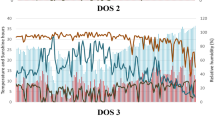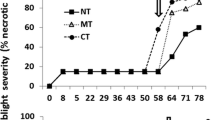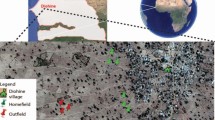Abstract
The effect of intercropping cowpea (Vigna unguiculata (L.) Walp.) with cassava (Manihot esculenta Crantz) or maize (Zea mays L.) on bacterial blight of cowpea caused by Xanthomonas axonopodis pv. vignicola was investigated in five cropping systems: cowpea monoculture at high density and at low density, cowpea-maize ‘within row’, cowpea-maize ‘in alternate rows’, and cowpea-cassava ‘in alternate rows’, in the forest savanna transition zone of Benin over two years. After inoculation of field border plants, disease severity index and incidence were measured as areas under the disease progress curve (AUDPC). The AUDPCs for disease incidence and severity were reduced in one of four treatments in each of two subsequent years, and one of four treatments in one year, respectively, in the ‘in alternate row’ patterns compared to monoculture at high density. Disease incidence was higher in cowpea monoculture at high density than in cowpea-cassava ‘in alternate rows’ in year 1996, and in cowpea-maize ‘in alternate rows’ in year 1997. The disease severity index was reduced by 50% in the cowpea-cassava ‘in alternate rows’ pattern in 1997, but not in 1996. Highest percentages of leaves with spots or blight occurred only in the cowpea monoculture at high density. Compared with monoculture, cowpea yield was about 60% in intercropping with cassava and about 40% in intercropping with maize. Cassava yielded 45–57% and maize 53–60% compared to monocropped cassava and maize, respectively. Comparing the land efficiency use of cowpea monoculture at high density to intercropping, the land equivalent ratio was similar in the intercropping systems with ‘alternate row’ patterns, and a yield loss of cowpea in intercropping was compensated by the additional yield of the intercrop. Although no stable effect of intercropping on disease reduction was observed, intercropping cowpea with maize or cassava ‘in alternate rows’ reduced bacterial blight in some cases and generally gives the farmer more yield security in case of failure of one crop. Therefore, intercropping as one element of an integrated control strategy for cowpea bacterial blight should not be abolished by farmers in favour of monocropping cowpea.
Zusammenfassung
Der Einfluss des Mischkulturanbaus von Augenbohne (Vigna unguiculata (L.) Walp.) mit Maniok (Manihot esculenta Crantz) oder Mais (Zea mays L.) auf den Bakterienbrand der Augenbohne, verursacht durch Xanthomonas axonopodis pv. vignicola, wurde in den fünf Anbausystemen ‚Augenbohne Monokultur bei hoher und niedriger Pflanzendichte’, ‚Augen- bohne-Mais in der Reihe’, ‚Augenbohne-Mais in alternieren den Reihen’ und ‚Augenbohne-Maniok in alternierenden Reihen’, in der Wald-Savannen-Übergangszone Benins über 2 Jahre untersucht. Nach künstlicher Inokulation von Randpflanzen der Versuchsfelder wurden der Krankheitsindex und die Befallshäufigkeit in Form der Fläche unter der Krankheitsentwicklungskurve (AUDPC) bestimmt. Die AUDPC-Werte für Symptomstärke und Befallshäufigkeit wurden in einer von 4 Varianten in beiden Jahren, beziehungsweise in einer von 4 Varianten in einem Jahr, in den Varianten ‚in alternierenden Reihen’ im Vergleich zur Monokultur bei hoher Pflanzdichte reduziert.
Die Befallshäufigkeit war höher in der ‚Augenbohnen-Monokultur bei hoher Dichte’ als in der Variante ‚Augenbohne-Maniok in alternierenden Reihen’ im Jahr 1996, und in der ‚Augenbohnen-Mais in alternierenden Reihen’ Variante im Jahr 1997. Ebenso war der Krankheitsindex im Jahr 1997 in der Variante ‚Augenbohne-Maniok in alternierenden Reihen’ um 50% reduziert, aber nicht im Jahr 1996. Die höchsten Prozentzahlen an Blättern mit Blattflecken oder Brandsymptomen wurden nur in der Variante ‘Augenbohne in Monokultur bei hoher Pflanzendichte’ gefunden. Im Vergleich zur Monokultur betrug der Augenbohnenertrag im Mischkulturanbau mit Maniok 60%, mit Mais 40%. Der Maniokertrag in Mischkultur betrug 45–57% und der Maisertrag 53–60% des Ertrages in Monokultur. Im Vergleich der Landeffizienznutzung von Augenbohnen Monokultur bei hoher Pflanzendichte mit Mischkulturanbau war das Landäquivalenzverhältnis in Mischkultur mit alternierenden Reihen ähnlich dem der Monokultur, und ein Ertragsverlust der Augenbohne im Mischkulturanbau wurde durch den zusätzlichen Ertrag der zweiten Kultur kompensiert. Obwohl kein stabiler Effekt des Mischkulturanbaus auf die Krankheitsreduktion beobachtet wurde, wurde der Bakterienbrand durch Mischkulturanbau von Augenbohne mit Mais oder Maniok in einigen Fällen reduziert. Desweiteren erhält der Farmer eine höhere Ertragssicherheit für den Fall des Verlustes einer Kultur. Deshalb sollte der Mischkulturanbau, als Komponente integrierter Bekämpfungsmaßnahmen des Bakterienbrandes, von den Bauern nicht durch den Anbau von Augenbohne in Monokultur ersetzt werden.
Similar content being viewed by others
Literature
Ahohuendo, B.C., S. Sarkar, 1995: Partial control of the spread of African cassava mosaic virus in Benin by intercropping. Z. Pflanzenk. Pflanzen. 102, 249–256.
Ahohuendo, B.C., R. Sikirou, 2005: Effet des associations manioc-maïs et manioc-niébé sur la population de Bemisia tabaci Gennadius et le développement de la mosaïque de manioc (Manihot esculenta Crantz) au sud du Bénin. Ann. Sci. Agronom. Benin 7, 159–173.
Boudreau, M.A., C.C. Mundt, 1992: Mechanisms of alteration in bean rust epidemiology due to intercropping with maize. Phytopathology 82, 1051–1060.
Boudreau, M.A., 1993: Effect of intercropping with maize on the severity of angular leaf spot of bean in Kenya. Plant Pathol. 42, 16–25.
Davis, J.H.C., J.N. Woolley, 1993: Genotypic requirement for intercropping. Field Crops Res. 34, 407–430.
Fininsa, C., 1996: Effect of intercropping bean with maize on bean common bacterial blight and rust diseases. Int. J. Pest Manage. 42, 51–54.
Fininsa, C., 2001: Epidemiology of Bean Common Bacterial Blight and Maize Rust in intercropping. PhD thesis, University of uppsala.
IITA (INTERNATIONAL INSTITUTE OF TROPICAL AGRICULTURE), 1988: Annual Report for 1986: Grain Legume Improvement Program. IITA, Ibadan, Nigeria.
Jeger, M.J., S.L.H. Viljanen-Rollinson, 2001: The use of the area under the disease progress curve (AUDPC) to assess quantitative disease resistance in crop cultivars. Theor. Appl. Genet. 102, 30–40.
Kaiser, W.J., A.H. Ramos, 1979: Two bacterial diseases of cowpea in East Africa. Plant Dis. Rep. 63, 304–308.
Khatri-Chhetri, G., K. Wydra, K. Rudolph, 1999: Variability of strains of Xanthomonas campestris pv. vignicola, incitant of cowpea bacterial blight and bacterial pustule, collected in several African and other countries. In: Mahadevan, A. (Ed.), Plant Pathogenic Bacteria, pp. 296–301. Centre for Advanced Study in Botany, University of Madras, India.
Kishun, R., R. Chand, 1989: Effect of sowing time and plant population on bacterial blight and yield of cowpea. Indian Phytopathol. 42, 268–275.
Lanter, J.M., 1990: Epidemiology of angular leaf spot of bean in monocultures and in bean-maize intercrops. PhD thesis, University of California, Berkley.
Maliki, R., M. Bernard, E. Padonou, 1997: Combined effect of NPK and three different types of mulch on maize production in southern Benin. In: RENARD, G., NEEF, A., BECKER, K., von OPPEN, M. (eds.): Soil Fertility Management in West African Land Use Systems, pp. 287–291. Margraf Verlag, Weikersheim, Germany.
Mead, R., R.W. Willey, 1979: The concept of a land equivalent ratio and advantages in yields from intercropping. Exp. Agric. 16, 217–218.
Michel, V.V., J.-F. Wang, D.J. Midmore, G.L. Hartman, 1997: Effects of intercropping and soil amendment with urea and calcium oxide on the incidence of bacterial wilt tomato and survival of soil-borne Pseudomonas solanacearum in Taiwan. Plant Pathol. 46, 600–610.
Moreno, R.A., 1979: Crop protection implications of cassava intercropping. In: Weber, E., Nestel, B., Campbell, M. (eds.): Intercropping with cassava, pp. 113–127. International Workshop. Trivandrum, India. International Development Research Centre, Ottawa.
Moreno, R., L. Mora, 1984: Effect of cropping pattern and soil management on plant diseases. II. Bean rust epidemiology. Turrialba 34, 41–45.
Okoli, O.O., A.F.K. Kissiedu, A. Asare-Bediako, 1996: Effect of planting dates and growth habits of cassava and cowpea on their yield and compatibility. Trop. Agric. (Trinidad) 73, 169–174.
Olasantan, F.O., 1988: Intercropping of cassava (Manihot esculenta) with maize or cowpea under different row arrangements. Field Crops Res. 19, 41–50.
Ouko, J.O., R.A. Buruchara, 1989: Influence of different cropping systems on incidence and severity of bacterial pustule of cowpea (Vigna unguiculata (L.) Walp) caused by Xanthomonas campestris pv. vignicola (Burkholder) Dye. Trop. Pest Manage. 35, 297–300.
Patel, P.N., 1981: Pathogen variability and host resistance in bacterial pustule disease of cowpea in Africa. Trop. Agric. 58, 275–280.
Patel, P.N., 1983: Resistance to bacterial blight in cowpeas in Tanzania and other countries. Indian J. Genet. 43, 9–13.
Shaner, G., R.E. Finney, 1977: The effect of nitrogen fertilization on the expression of slow-mildewing resistance in Knox wheat. Phytopathology 67, 1051–1056.
Sikirou, R., 1999: Epidemiological investigations and development of integrated control methods of bacterial blight of cowpea caused by Xanthomonas campestris pv. vignicola (Burkholder) Dye. PhD thesis, University of Göttingen.
Sikirou, R., K. Wydra, 2004: Persistence of Xanthomonas axo- nopodis pv. vignicola in weeds and crop debris and identification of Sphenostylis stenocarpa as a potential new host. Eur. J. Plant Pathol. 110, 939–947.
Sikirou, R., K. Wydra, 2003: Selection of local and improved cowpea genotypes resistant to bacterial blight caused by Xanthomonas axonopodis pv. vignicola. Ann. Sci. Agronom. Benin 6, 49–60.
Sikirou, R., K. Wydra, K. Rudolph, 2001: Selection of cowpea genotypes resistant to bacterial blight caused by Xanthomonas campestris pv. vignicola. In: DeBoer, S., (ed.): Plant Pathogenic Bacteria, pp. 309–314. Kluwer Academic Publishers, Dordrecht, Netherlands.
Trenbath, B.R., 1993: Intercropping for the management of pests and diseases. Field Crops Res. 34, 381–405.
Vakili, N.G., W.J. Kaiser, J.A. Perez, A. Cortés-Monllor, 1975: Bacterial blight of beans caused by two Xanthomonas pathogenic types from puerto Rico. Phytopathology 65, 401–403.
Van Rheenen, H.A., D.E. Hasselbach, S.G.S. Muigai, 1981: The effect of growing beans together with maize on incidence of bean diseases and pests. Neth. J. Plant Pathol. 7, 193–199.
Vauterin, L., B. Hoste, K. Kersters, J. Swings, 1995: Reclassification of Xanthomonas. Int. J. System. Bacteriol. 45, 472–489.
Wydra, K., A. Fanou, R. Sikirou, M. Zandjanakou, V. Zinsou, K. Rudolph, 2001: Integrated control of bacterial diseases of cassava and cowpea in West Africa. In: DeBoer, S., (ed.): Plant Pathogenic Bacteria, pp. 280–287. Kluwer Academic Publishers, Dordrecht, Netherlands.
Wydra, K., K. Rudolph, 1999: Development and implementation of integrated control methods for major diseases of cassava and cowpea in West-Africa. Gött. Beitr. Land- Forstwirtsch. Trop. Subtrop. 133, 174–180.
Zinsou, V., K. Wydra, B. Ahohuendo, B. Hau, 2004: Effect of soil amendments, intercropping and planting time in combination on the severity of cassava bacterial blight and yield in two ecozones of West Africa. Plant Pathol. 53, 585–595.
Author information
Authors and Affiliations
Corresponding author
Rights and permissions
About this article
Cite this article
Sikirou, R., Wydra, K. Effect of intercropping cowpea with maize or cassava on cowpea bacterial blight and yield. J Plant Dis Prot 115, 145–151 (2008). https://doi.org/10.1007/BF03356262
Received:
Accepted:
Published:
Issue Date:
DOI: https://doi.org/10.1007/BF03356262
Key words
- Africa
- integrated management
- intercropping
- Xanthomonas axonopodis pv. vignicola
- Xanthomonas campestris pv. vignicola




